Extinction in Costa Rica
I love Costa Rica and its wildlife, and I sometimes envy the pioneers who lived here in the early 1900s and were able to know and appreciate some of the wildlife that are no longer with us. I am thinking of one mammal and one bird in particular, the Giant Anteater and the Harpy Eagle. Both of these truly magnificent species once lived in Costa Rica. Today the former is almost certainly gone forever, and there still may be a few of the latter in several remote locations in the country. Though it is not yet extinct, I will also mention the Jabiru Stork. Let’s have a closer look.
Giant Anteater (Myrmecophaga tridactyla)
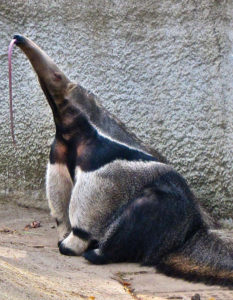 This large mammal is similar in many respects to the anteater many of us know today as the Tamandua (Tamandua mexicana): long curved nose, long curved claws that tuck completely under like a fist and obliges them to walk on their knuckles, and both eat ants and termites. The biggest difference is the size. A large tamandua can weigh up to 5 kilos and is about 60 cm long, and the giant anteater, sometimes called the “ant bear”, weighs eight times as much, and is more than double the length. In Costa Rica they are called Oso Caballo in Spanish, which literally translates to “Bear Horse”, presumably because of its large size and big, round, furry appearance. I had the good fortune to see two giant anteaters on my once-in-a-lifetime trip to the Pantanal in Brazil. Both were at night, and neither would let me get close enough to take a photo. Our guide told us that they eat mostly ants, first digging an opening into the ant hill, inserting the long narrow snout as far as possible, and then inserting the sticky, snake-like tongue, which is as long as a man’s arm, deep into the nest to retrieve the ants. He said that the anteater can flick its tongue in and out at the awesome rate of about twice per second. After a very short time it moves on to another nest. This may be because the soldier ants that guard the nest from intruders quickly come out in force. With their long powerful pinchers they may be able to penetrate the thick hairy hide that protects the animal from ordinary ants.
This large mammal is similar in many respects to the anteater many of us know today as the Tamandua (Tamandua mexicana): long curved nose, long curved claws that tuck completely under like a fist and obliges them to walk on their knuckles, and both eat ants and termites. The biggest difference is the size. A large tamandua can weigh up to 5 kilos and is about 60 cm long, and the giant anteater, sometimes called the “ant bear”, weighs eight times as much, and is more than double the length. In Costa Rica they are called Oso Caballo in Spanish, which literally translates to “Bear Horse”, presumably because of its large size and big, round, furry appearance. I had the good fortune to see two giant anteaters on my once-in-a-lifetime trip to the Pantanal in Brazil. Both were at night, and neither would let me get close enough to take a photo. Our guide told us that they eat mostly ants, first digging an opening into the ant hill, inserting the long narrow snout as far as possible, and then inserting the sticky, snake-like tongue, which is as long as a man’s arm, deep into the nest to retrieve the ants. He said that the anteater can flick its tongue in and out at the awesome rate of about twice per second. After a very short time it moves on to another nest. This may be because the soldier ants that guard the nest from intruders quickly come out in force. With their long powerful pinchers they may be able to penetrate the thick hairy hide that protects the animal from ordinary ants.
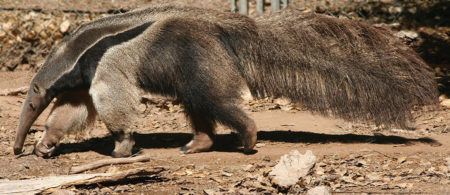 The last confirmed sighting of an ant bear in the Costa Rica was in Guanacaste in 1984 and there were several sightings in the Peninsula de Osa during the 1960s and 70s, but these beautiful mammals are almost certainly all gone now. My good friend Patrick O’Connel better known as the “Gold Walker” walked over every inch of the Osa Peninsula for 26 years, beginning in 1966, buying gold. He saw a tremendous amount of wildlife but says that he never saw a giant anteater nor heard of a sighting from a credible observer.
The last confirmed sighting of an ant bear in the Costa Rica was in Guanacaste in 1984 and there were several sightings in the Peninsula de Osa during the 1960s and 70s, but these beautiful mammals are almost certainly all gone now. My good friend Patrick O’Connel better known as the “Gold Walker” walked over every inch of the Osa Peninsula for 26 years, beginning in 1966, buying gold. He saw a tremendous amount of wildlife but says that he never saw a giant anteater nor heard of a sighting from a credible observer.
Some sources say that they are hunted for their fur and meat. I imagine that they also kill hunter’s dogs and hunters retaliate by killing ant bears. The much smaller tamandua is capable of meting out very nasty gashes with its long powerful claws when attacked by dogs. I can only imagine what would happen to a dog if a Giant Anteater got a hold of it. There are several recorded cases of giant anteaters killing humans that got too close and tried to mistreat the animal.
Harpy Eagle (Harpia harpyja)
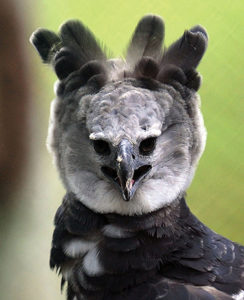 I have seen bald eagles and golden eagles and always thought of them as very large hawks, but at almost a meter tall and weighing up to five kilos, this bird of prey is huge and robust. It is possible that there are a few harpy eagles still to be found in Costa Rica, perhaps in the Osa peninsula or Talamanca. If so, it is probable that wildlife authorities are not divulging the information to the general public. Many years ago a park ranger in Corcovado National Park told me that they had been monitoring a nest with one healthy chick that was getting close to fledging. One day the chick disappeared. Later they heard rumors that a poacher had climbed the tree, stolen the young bird, and sold it to a foreigner for a great deal of money. This type of poaching may be the greatest threat to the Harpy Eagle. How much would an unscrupulous collector or dealer be willing to pay for a healthy chick of the largest and most powerful raptor in the world. I can only imagine.
I have seen bald eagles and golden eagles and always thought of them as very large hawks, but at almost a meter tall and weighing up to five kilos, this bird of prey is huge and robust. It is possible that there are a few harpy eagles still to be found in Costa Rica, perhaps in the Osa peninsula or Talamanca. If so, it is probable that wildlife authorities are not divulging the information to the general public. Many years ago a park ranger in Corcovado National Park told me that they had been monitoring a nest with one healthy chick that was getting close to fledging. One day the chick disappeared. Later they heard rumors that a poacher had climbed the tree, stolen the young bird, and sold it to a foreigner for a great deal of money. This type of poaching may be the greatest threat to the Harpy Eagle. How much would an unscrupulous collector or dealer be willing to pay for a healthy chick of the largest and most powerful raptor in the world. I can only imagine.
About 20 years ago one young, lone male was reported in Corcovado. It flew in one morning and landed in a tree near the Sirena Biological Station. A biologist friend, one of about a dozen witnesses, told me that when the huge bird of prey landed in a large tree at the edge of the forest, a group of spider monkeys that had been foraging in the crown of a nearby tree within sight of the eagle, literally plunged into the lower branches and cowered there until it flew away. It had been many years and several generations since any monkey in the park had seen a Harpy Eagle, yet the fear was so embedded in their instinct that they immediately perceived the threat and reacted accordingly. Harpy eagles’ primary prey are monkeys and sloths which they snatch out of the crowns of rainforest trees.
It is known that there are still a few in Panama, Venezuela and Surinam. Hopefully we still have a few in Costa Rica.
Jabiru Stork (Jabiru mycteria)
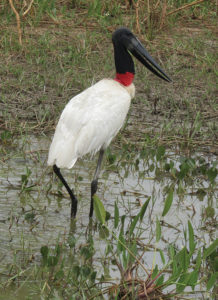 Any discussion of extinction in Costa Rica should include the Jabiru Stork. There are still a few left in the wetlands of the Tempisque Basin, but the population is so small that it is probably seriously inbred, and will not likely survive. Ornithologists are monitoring them closely. Several years ago there were still 23 individuals including several nesting pairs. Though wildlife officials were monitoring the birds closely one adult disappeared from the nest where it was incubating an egg. Devastated by the news the wildlife inspectors launched an investigation. Several days later they found feathers near a farm worker’s home. The man admitted that he had killed the magnificent bird, and he and his family had eaten it. I’m sure he has no idea of the true value of that meal.
Any discussion of extinction in Costa Rica should include the Jabiru Stork. There are still a few left in the wetlands of the Tempisque Basin, but the population is so small that it is probably seriously inbred, and will not likely survive. Ornithologists are monitoring them closely. Several years ago there were still 23 individuals including several nesting pairs. Though wildlife officials were monitoring the birds closely one adult disappeared from the nest where it was incubating an egg. Devastated by the news the wildlife inspectors launched an investigation. Several days later they found feathers near a farm worker’s home. The man admitted that he had killed the magnificent bird, and he and his family had eaten it. I’m sure he has no idea of the true value of that meal.
At 1.35 meters tall, almost chin high on me, and weighing about 6½ kilos, this enormous stork is easily the largest bird in Costa Rica. I had the good fortune to see and photograph many of the tall, stately Jabirus during my trip to the Pananal. The photos shown here are from that trip.

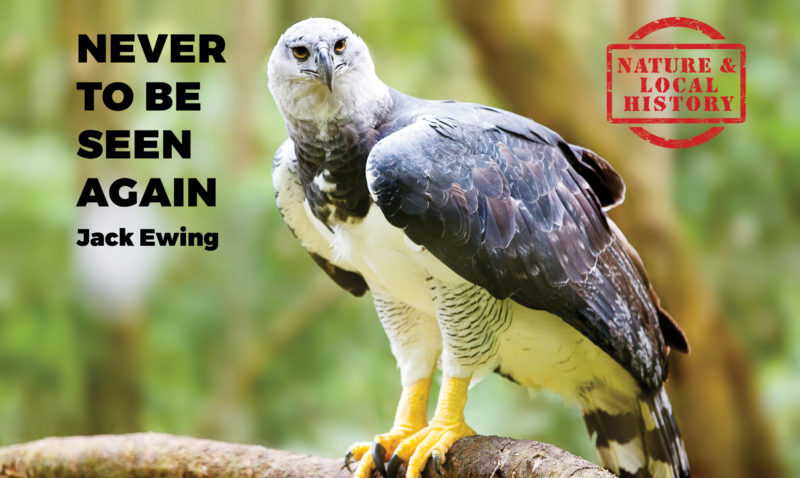

I photographed a White Headed (apparent) bird of prey this morning 4/5/2020 (April 5, 2020). It was with my iPhone on full zoom and cannot make out what it is. I tried numerous photos in an effort to capture its’ beak in profile but cannot make out whether it was successful. I questioned if it was a Baled Eagle, but don’t know if they are indigenous. How may I forward a sampling of images to you? Edit: Photo taken between Flamingo and Potrero – in the Potrero side, overlooking a small beach.
I photographed a White Headed (apparent) bird of prey this morning 4/5/2020 (April 5, 2020). It was with my iPhone on full zoom and cannot make out what it is. I tried numerous photos in an effort to capture its’ beak in profile but cannot make out whether it was successful. I questioned if it was a Baled Eagle, but don’t know if they are indigenous. How may I forward a sampling of images to you?
Giant anteaters have only two natural predators — pumas and jaguars. Sometimes the anteaters try to outrun their attackers, but other times they fight. Rearing up on their hind legs, they slash at their foes with their sturdy forearms and sharp claws (which can be up to four inches long!). Giant anteaters have also been known to grab an attacker, crushing it with their powerful front limbs. These are not anteaters to be trifled with! READ MORE @ St Louis Zoo

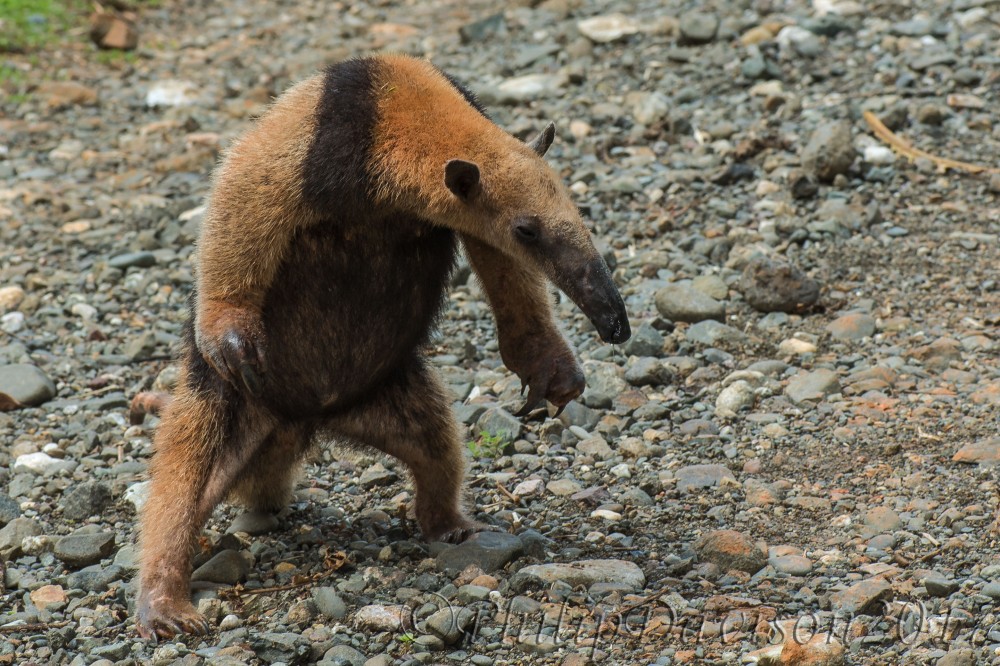
I don’t see a weapon on the antbear lethal enough to kill a dog.